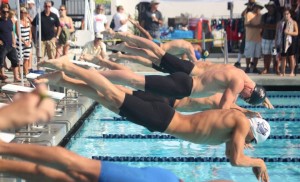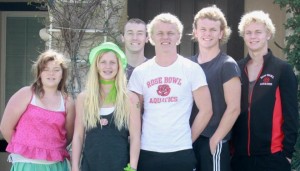By Ogden M. Forbes, Ed.D. and Jane Forbes, R.N.
Swimming is fun! No doubt about it. Â Did you know that because water provides relief from impact on our joints while still providing resistance to our muscles it is a great place for people who have hemophilia to build stronger bodies? Â It’s true and for many families swimming has become just the thing to provide not only fun, but a great form of exercise to keep a bleeders body healthy and strong. Â The Forbes family from Pasadena, California is living this example. Â Learn more about them and how finding a swimming facility in their area has positively impacted their lives.
Each year as the holiday season begins; the Forbes family gives thanks for the many gifts and blessings we have received. Perhaps no gift has been greater for our family than the discovery of an oasis in our neighborhood-an oasis that brings strength to our four sons with severe hemophilia A, many years of friendships, national recognition for swimming competitiveness, trips to the Olympic training center in Colorado, nationwide team travel trips, confidence that their futures will be bright, and freedom from joint bleeds for many years! It is the oasis known today as the Rose Bowl Aquatics Center-a non-profit organization in Pasadena, California. Now that our children are becoming fully independent adults, moving on to college, and self-infusing, we wanted to share a few insights we have learned along the way.
To minimize bleeding episodes, it is commonly known that individuals must infuse prophylactically. It is also known that selective exercising can help reduce bleeding episodes by strengthening those muscles around the target joints that support the bones that frequently cause the bleeding to occur. For many years, hematologists have been producing top lists of exercises and sports most helpful to those with bleeding disorders. For years, swimming has been at the very top of these lists.  No other form of exercise or sport comes close to providing for the unique medical needs of those with bleeding disorders. Why is this true?
First, swimming provides buoyancy, an all-surrounding, anti-gravity environment. For approximately 10 years, our sons have been swimming from two to three hours a day, six days a week, in this environment. In other words, our sons have been strengthening their muscles in the pool where their bones and the weight of their bodies, cannot in any way cause bleeding. No other sport can provide this buoyant, anti-gravity environment. Is it any wonder why many professional athletes almost universally part icipate in a variety of anti-gravity rehabilitation exercises?
icipate in a variety of anti-gravity rehabilitation exercises?
Second, swimming brings viscosity, an all-surrounding natural resistance applicable to all movement directions, to the athletic environment. Exercise intensity can be varied easily by increasing surface area or movement speed. Thus, the swimming exercise becomes a highly efficient workout for nearly all individuals, no matter the age, the conditioning, the weight, or the experience.
Third, swimming provides a substantial reduction in momentum. Speed is reduced caused by the resistance of the all-surrounding water- reduction that nearly eliminates any form of impact or trauma. Though our sons are outstanding competitors, their swimming speeds will never match the speed of athletes running or bicycling precisely, because those athletes experience much less overall environmental resistance.
Finally,swimming is a sport that can be enjoyed for nearly the entire length of an individual’s life. Long after swimmers return from college, they can be found competing in Masters Competitions all over the country. It is not uncommon to see such swimmers at the ages of 60s, 70s, and 80s. Those with bleeding disorders can live almost their entire lives without further bleeding episodes by following this path open to them.
This is not to say that swimming cannot lead to bleeding episodes. It is important to be careful with slippery decks. It is also important to master proper stroke and turn techniques to minimize injury. Fortunately, our sons have gone another year without joint bleeds and have no joint damage.  In their annual checkups with their doctor, their range of motion is absolutely unimpeded. They suffer no arthritic problems. Thus, the Forbes family is thankful. Ultimately, their success has everything to do with the oasis in our neighborhood.
Doctors cannot prescribe buoyancy, environmental viscosity, or reduction in momentum sports.  But doctors can prescribe aquatics therapy. Younger parents may be able to embrace the recommendations of hematologists, find the swimming pools, and manage the time of their children in this process. Knowledge and commitment are essential for parents considering competitive swimming.
Families nationwide have been encouraging their children affected with a b leeding disorder to swim in clubs and on high school teams, with incredible levels of competitive success.  Our hope is that this appreciation for swimming for individuals with bleeding disorders will continue to increase, and that there will be many more families in the years ahead that will turn to swimming as a perfect complement to the regular prophylactic factor therapy that they now embrace.
leeding disorder to swim in clubs and on high school teams, with incredible levels of competitive success.  Our hope is that this appreciation for swimming for individuals with bleeding disorders will continue to increase, and that there will be many more families in the years ahead that will turn to swimming as a perfect complement to the regular prophylactic factor therapy that they now embrace.
Michael and Jane Forbes have six children, the four sons all having severe hemophilia A. Michael earned a Doctorate in Education from the University of San Francisco.  For several years, he ran in marathons and is currently a sports enthusiast. Jane earned her Registered Nursing degree from Seneca College in Toronto, Canada.  For several years, she trained in Judo and was a Junior Olympian in this sport
_______________________________________



